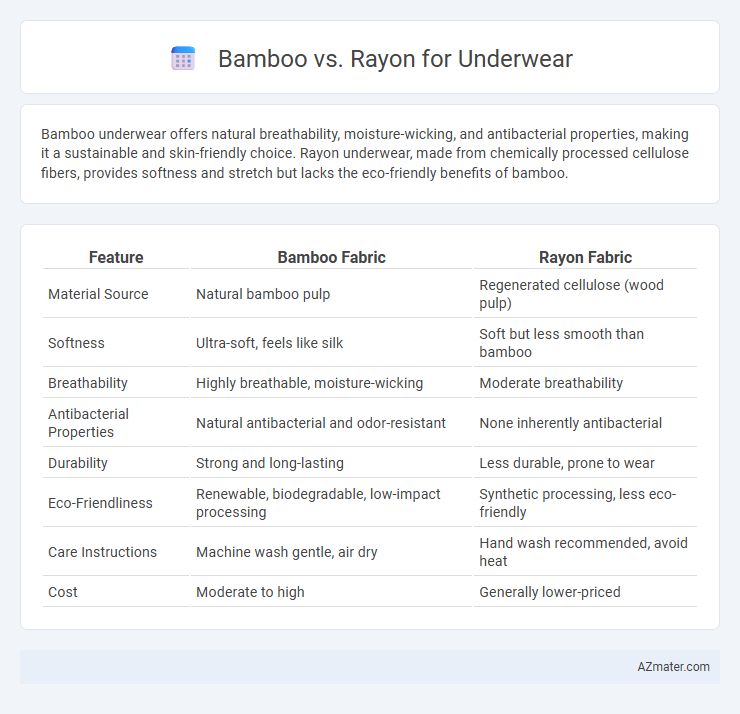Bamboo underwear offers natural breathability, moisture-wicking, and antibacterial properties, making it a sustainable and skin-friendly choice. Rayon underwear, made from chemically processed cellulose fibers, provides softness and stretch but lacks the eco-friendly benefits of bamboo.
Table of Comparison
| Feature | Bamboo Fabric | Rayon Fabric |
|---|---|---|
| Material Source | Natural bamboo pulp | Regenerated cellulose (wood pulp) |
| Softness | Ultra-soft, feels like silk | Soft but less smooth than bamboo |
| Breathability | Highly breathable, moisture-wicking | Moderate breathability |
| Antibacterial Properties | Natural antibacterial and odor-resistant | None inherently antibacterial |
| Durability | Strong and long-lasting | Less durable, prone to wear |
| Eco-Friendliness | Renewable, biodegradable, low-impact processing | Synthetic processing, less eco-friendly |
| Care Instructions | Machine wash gentle, air dry | Hand wash recommended, avoid heat |
| Cost | Moderate to high | Generally lower-priced |
Introduction to Bamboo and Rayon Fabrics
Bamboo fabric is derived from the pulp of bamboo grass, known for its natural antibacterial properties, breathability, and eco-friendly cultivation process. Rayon, a semi-synthetic fiber made from regenerated cellulose typically sourced from wood pulp, offers a smooth, silky texture and excellent moisture-wicking capabilities. Both fabrics are popular choices for underwear due to their softness and comfort, but their production methods and sustainability profiles differ significantly.
Understanding the Source: Bamboo vs Rayon
Bamboo fibers used in underwear come from the natural cellulose of bamboo plants, processed mechanically or chemically to retain strength and breathability. Rayon, often derived from bamboo, involves a more intensive chemical process that converts bamboo cellulose into a regenerated fiber, impacting environmental and fabric qualities. Understanding these sources helps distinguish bamboo underwear's eco-friendliness from rayon's smoother texture but higher chemical footprint.
Manufacturing Process Comparison
Bamboo underwear manufacturing involves processing bamboo fibers through mechanical or chemical methods, with the mechanical process using natural enzymes to break down the plant's woody parts, creating a softer fabric, while chemical processing converts bamboo into viscose or rayon through solvent spinning. Rayon underwear, specifically viscose rayon, is produced via a chemical-intensive process where cellulose from wood pulp is dissolved in chemicals like sodium hydroxide and carbon disulfide, then regenerated into fibers, raising environmental concerns due to the use of toxic solvents. Bamboo viscose production shares similarities with rayon, but bamboo underwear marketed as "bamboo" is often rayon derived from bamboo cellulose, blending eco-friendly claims with synthetic fiber manufacturing realities.
Softness and Comfort: Which Feels Better?
Bamboo underwear offers exceptional softness due to its natural fibers, which are smoother and more breathable compared to rayon, enhancing overall comfort. Rayon, while also soft, tends to have a slightly synthetic texture that may not match the silky feel of bamboo fabric. For those prioritizing skin-friendly comfort and moisture-wicking properties, bamboo underwear generally feels better against the skin.
Breathability and Moisture-Wicking Abilities
Bamboo fabric excels in breathability due to its natural micro-gaps and hollow fibers, which enhance air circulation and keep skin cool. Rayon, often derived from wood pulp, offers moderate breathability but lacks the inherent moisture-wicking properties of bamboo. Bamboo underwear effectively absorbs moisture and dries quickly, making it ideal for maintaining comfort and reducing odor during extended wear.
Durability and Longevity of Underwear
Bamboo underwear offers moderate durability due to its natural fibers but tends to weaken faster with frequent washing and wear compared to rayon. Rayon, a semi-synthetic fiber derived from cellulose, provides greater strength and resilience, maintaining its shape and softness over time. Choosing rayon underwear often results in longer-lasting garments, especially under repeated stress and laundering, whereas bamboo underwear excels in breathability and eco-friendliness but may sacrifice some longevity.
Environmental Impact: Bamboo vs Rayon
Bamboo underwear is often praised for being eco-friendly due to bamboo's rapid growth without pesticides or fertilizers, requiring less water compared to traditional cotton. Rayon, while derived from natural cellulose like bamboo, involves chemical-intensive processing that can produce toxic waste harmful to water sources and ecosystems. Choosing bamboo over rayon underwear can significantly reduce environmental footprint, especially when using mechanically processed bamboo fibers instead of chemically treated rayon fabrics.
Skin Sensitivity and Hypoallergenic Properties
Bamboo fabric is known for its natural hypoallergenic properties, making it highly suitable for sensitive skin as it resists irritation and allergies more effectively than rayon. Unlike rayon, which is a semi-synthetic fiber often treated with chemicals during manufacturing, bamboo fibers retain natural antibacterial qualities that reduce skin inflammation and promote breathability. Consumers with skin sensitivity benefit from bamboo underwear due to its moisture-wicking ability and gentle texture, while rayon may sometimes cause discomfort or allergic reactions due to its chemical processing.
Cost and Accessibility
Bamboo underwear typically costs more due to sustainable harvesting and eco-friendly processing, whereas rayon derived from bamboo fibers offers a cheaper alternative but involves chemically intensive manufacturing. Accessibility varies as rayon underwear is more widely available in mainstream markets, while genuine bamboo fabric products can be niche and limited to eco-conscious retailers. Consumers seeking affordable everyday underwear often opt for rayon, despite its environmental trade-offs, while those prioritizing sustainability invest in bamboo options at a higher price point.
Final Verdict: Choosing the Best for Underwear
Bamboo underwear excels in breathability and natural antibacterial properties, making it ideal for sensitive skin and everyday comfort. Rayon, often derived from bamboo but chemically processed, offers a smooth texture and affordability but may lack durability and eco-friendliness. For the best underwear choice, prioritize bamboo for natural softness and sustainability, while Rayon suits budget-conscious buyers seeking silky fabrics.

Infographic: Bamboo vs Rayon for Underwear
 azmater.com
azmater.com